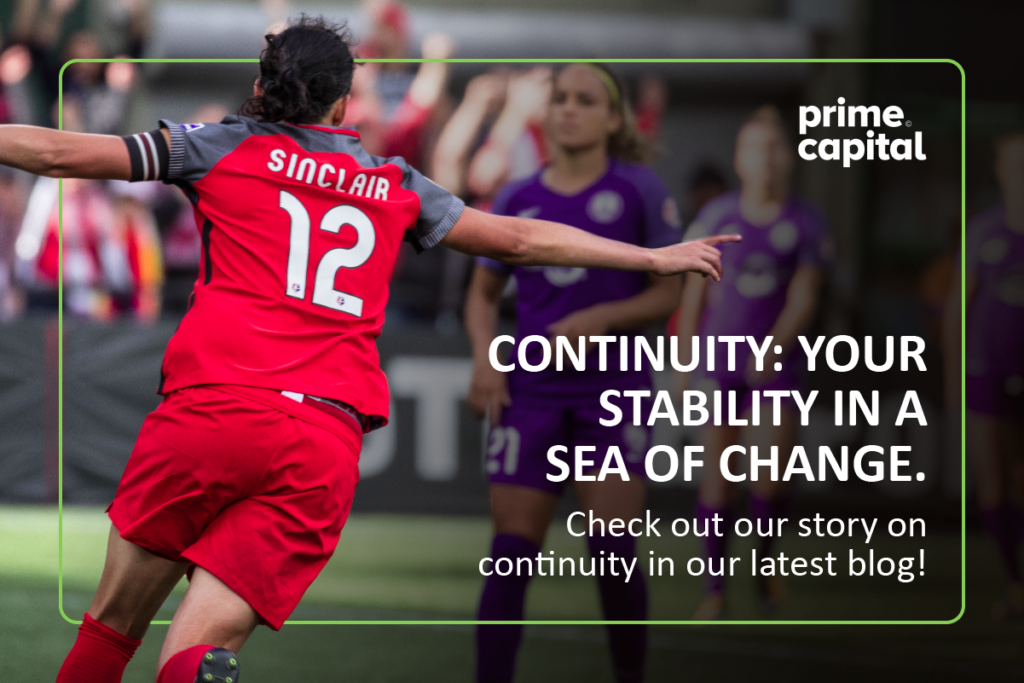Defining Continuity is quite simple. It means the unbroken and consistent existence or operation of something over a period of time, whether that be an action or a feature. However, as we see on this blog, things get more philosophical when we apply this simple term to growing your business.
After exploring Capital and Capacity in previous blogs, today’s focus will be on how you navigate the good, the bad, and the ugly of your business’s future. Together, I hope our three “Waters of Business Life” make for a fulfilling arc—Capital as a prerequisite to launch, Capacity for how your business grows, and finally, Continuity for what to do when the times get tough. Because if no one has broken the news yet, I’m sorry to say, but times will get tough.
Luckily, with a little practice, you can toughen up alongside them. To prove it, let’s give an example from one of the most fastest growing but slowest evolving businesses of all—women’s soccer.
In December 2023, my husband and I invested a few hours hanging out at BC Place. People were out in greater numbers, meeting up with family and friends before the holidays began in earnest. We found ourselves walking through the massive structure, nestled neatly into the same bay that holds Science World and many other Vancouver tourist traps.
As a fan of women’s soccer, I was delighted to see the arena temporarily renamed Christine Sinclair Place to celebrate the final national team game of iconic Christine Sinclair. Sinclair retired from her role after 24 years of leading the Canadian women’s National soccer team and being the world’s most prolific international goal scorer of ANY gender.
Suppose you’re a sports fan but not a soccer fan. In that case, Sinclair is soccer’s answer to hockey stars Wayne Gretzky or Gordie Howe or basketball’s Karim Abdul-Jabbar. She is a living legend, made all the cooler when you consider her journey.
The Start-up Phase
The inaugural CanWN Team was formed on Canada Day in 1986 with a development budget of $12000. Contrast this with the men’s team budget of 1.7MM in the same year, and you might feel some kinship comparing your start-up to your competitors. While it might have been daunting, the team was dedicated, passionate, and hardworking.
Spirit triumphed in those early years. Between 1986 and 1999, the team played on and off the continent, fighting resource gaps, wins and losses, the retirement of key players, and a constant change in coaches. While internal conflict, frustration on progress and funding, and changes in the team members created hurdles, the team players kept leaping over the obstacle de jour with the same ferocity we see in cutthroat start-ups. Players were tired but happy to be playing for their country. Even better, they were fighting for a vision.
New Capital, New Capacity, Same Continuity
The next decade saw the improvement of the CanWN Team’s talent pool and resources—not to mention a handful of impressive wins during games in international matches. With a new coach, new styles, new tactics, and more new talent, the team rounded out a growth period ending with Canada in the semi-final against their dominant US rivals in the 2012 Olympic games. In that critical game, they earned a Canadian history-making bronze medal.
The news called it an “overnight success.” We know it was 26 years worth of “overnights,” but nonetheless, this win was a game-changer, and much like your first paycheque from your start up company, it was followed by this life-searching thought:
What the heck now?
Scrappy Start-Up Vs. Market Incumbent
All organizations go through the growth stages, but not all go through them successfully.
If I had a nickel for every time I saw a company ‘breakthrough’ to the big times without breaking a sweat… Well, I’d be poor.
It just never happens.
Yes, I know, you’ve heard about the unicorn story where someone writes a plan on a napkin, lands the multi-million dollar investment from well-connected investors, builds an MVP, and sells it before ever getting to the revenue stage, but let’s face it. That might make good television, but it doesn’t stand up to real life..
The reality, however disappointing, is that the ones who made it had to survive for a long time. They had to beat out competitors, overcome internal strife and friction, and survive when there was no money in the bank for the paycheques. Sometimes, it wasn’t even their fault! Often, top customers go bankrupt and take the paycheques with them. It’s the law of the jungle out there, and not all of us are Tarzan.
The survivors had to tie pieces of string together when the rope broke. They hustled at trade shows for years before they landed a skeptical customer. They pitched, iterated, re-pitched, modified, sold their kidneys for more time, and finally won, and then dropped the ball, with an important client. Their sole shipper/receiver person quit mid-delivery deadline while their accountant gave up the calculator for good to live on a Luddite compound.
Their bank decided they didn’t want to be in ‘that’ market anymore and invited them to leave. The supplier of the key ingredient didn’t deliver on time, meaning they missed the all-important retail season. They didn’t pay their taxes (because they thought they needed to keep the cash on hand and could pay them later) and ended up with the bank account frozen by the tax authorities. That made them miss (another) payroll period, and the staff wavered. To most, loyalty doesn’t come cheap, and honestly, I don’t blame them.
What do you do when the chips are down and you lose capital (money) and capacity (staff)?
Savvy owners remortgage their homes, sell their grandfather’s Johnny Cash album collection, convince investors to lend them some capital and pour the money back into the bank to release their accounts. This gets back to taking care of clients and their teams and building for the future.
They may cry into their coffee at 4 AM (and into an occasional beer at 9 PM) while still at their desk, but this time, it’s on their terms.
The team rallied when things got hectic, pulled together when there was an important deadline, and helped innovate the product to make it work for more clients. Families of the team helped just as much by being patient, supporting that inventory count weekend, and attending the team event to help celebrate the hard work they had all put in to get through the challenging year.
The survivors have stories. More than that, they have scars. But like any suffering, it has to be for a reason. For your business, Continuity will be that guiding star.
Building Your Continuity Plan—Equal Parts ‘How’ and ‘Why’
After the Olympics, the CanNW Team retooled itself. Their identity was gelling thanks to a depth of player field it had never had. This was thanks in part to a story they told in their struggles and eventual wins—decades of being role models for young up-and-coming players.
The team had developed wonderful defence depth but relied too heavily on Christine Sinclair for scoring. Sure, defence is critical to the game, but not only is a nil-nil game not exciting to watch, it’s not very inspiring for the players.
There were two competing thoughts. On one hand, having a good backbone for the team allowed Christine to do what she did best. Not to mention, the women’s events were becoming more and more competitive every year. On the other hand, what happens when Christine leaves or gets injured? Do we invest in the offence or defence?
You may have been here with your own business. D you invest in new equipment and grow in new markets, or do you invest in the backshop and nail down that quality control? (both are important, and equipment leasing is an answer you can check out here!
Success Isn’t a Valid Measurement
Name any organization that achieved its objective within earshot of the first planning meeting. I’ll wait.
Canada’s team followed the trajectory of most organizations. They started with inspiration but no resources, struggled to get themselves together, faced challenges in marketing, overcame internal growing pains, and spent years just figuring out what they were actually good at.
Finding yourself is most of the battle. That’s when the scaling dream gets fulfilled, when you know what you are, and can do that more and more flawlessly.
The last phase of Christine’s incredible career at the helm of this team was no less difficult. After getting used to yet another coach and overcoming injuries and self-doubt, the team was literally standing on the line, trading penalty shots to decide the game outcome in the final game of the 2020 Tokyo Olympics.
With a record-breaking 4.4 MM viewers (including me) glued to their screens, Canada beat challenger Sweden to take the gold medal. Watching that game, it felt right that Christine Sinclair, a stalwart in her leadership and commitment to the goal, selfless in her drive for the team’s success, was finally taking home the big prize.
It felt pretty damn perfect.
But success isn’t permanent. In 2023, Canada was ousted early from the FIFA Women’s World Cup in Australia.
That’s okay. Since they know they can win, we know it just wasn’t their day. There is beauty in that resilience, just as you’ve learned as an entrepreneur.
So, what the heck does this have to do with Continuity?
Continuity As a Template
Over many long years, the CanNW Team gradually (and sometimes painfully for their supporters) retooled, reframed, rebuilt, retrained and reconstructed itself, and tweaked the chemistry. Just like muscles, every time they were pressed to their breaking point, they came back a bit stronger.
They now have a player bench that is amazingly talented—not just from dedicated years of building a quality player funnel across the country’s junior sports teams but by recruiting great coaches, support team members, and fans. In 1986, there was no team. In 2023, that team is world-renowned not just for its reluctant star but for its story and its scars.
In 2023, those players have joined professional teams around the world, getting more depth every season and more experience and bringing that skill back home to encourage and excite the fans and the next generation of players all over again. It’s like how when you invest in your team’s skills and passions outside of work, they bring that energy back into the main goal.
But what is the goal? Is it to elevate a scoring machine until her name is literally up in lights? Is it to inspire others to join the field? Or is it to simply stay in the game?
This is why Continuity is crucial. With it, you may be able to consider, and answer, those questions.
Retirement, or Just Beginning
It is my opinion (decidedly personal, ask me about it! that the reason Christine Sinclair finally retired from the team that she loves is that she could see the future. It was right there on the field with her—the team as a growing enterprise, eventually scaling to the point that it no longer needed her in the game. This should be familiar to you as a business owner, whether selling to family, investors, or just closing the door once your mission is over.
Part two of this Continuity blog will discuss how to plan your long- and short-term future. Until then, don’t sweat the little things—unless you’re in Vancouver like me, trying to keep lunch down on the bumpy ferry ride. Then, sweating is entirely appropriate. Where’s the bathroom on this thing again?



